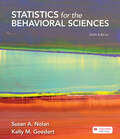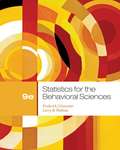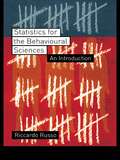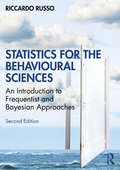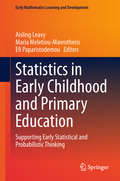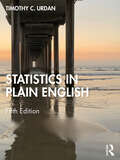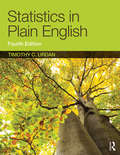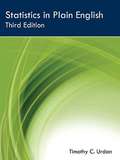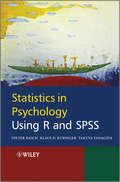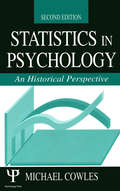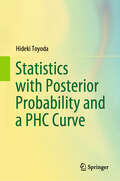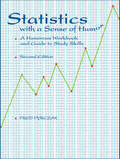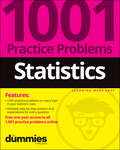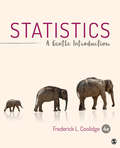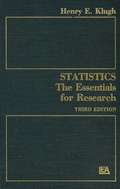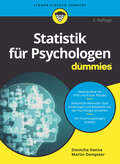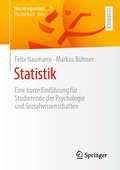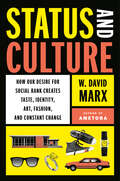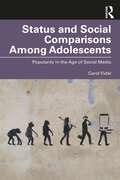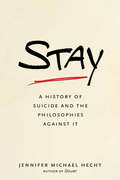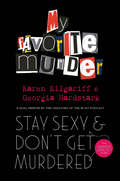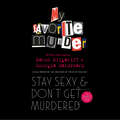- Table View
- List View
Statistics for the Behavioral Sciences
by Susan A. Nolan Kelly M. GoedertStatistics Matter! Statistics for the Behavioral Sciences teaches you how and why.
Statistics for the Behavioral Sciences (9th Edition)
by Larry B. Wallnau Frederick J GravetterThe author illustrates the importance of statistics in the study of behavioral science and how it provides researchers with objective and systematic methods for describing and interpreting their research results.
Statistics for the Behavioural Sciences: An Introduction
by Riccardo RussoDo you find statistics overwhelming and confusing? Have you ever wished for someone to explain the basics in a clear and easy-to-follow style? This accessible textbook gives a step-by-step introduction to all the topics covered in introductory statistics courses for the behavioural sciences, with plenty of examples discussed in depth, based on real psychology experiments utilising the statistical techniques described. Advanced sections are also provided, for those who want to learn a particular topic in more depth.Statistics for the Behavioural Sciences: An Introduction begins with an introduction to the basic concepts, before providing a detailed explanation of basic statistical tests and concepts such as descriptive statistics, probability, the binomial distribution, continuous random variables, the normal distribution, the Chi-Square distribution, the analysis of categorical data, t-tests, correlation and regression. This timely and highly readable text will be invaluable to undergraduate students of psychology, and students of research methods courses in related disciplines, as well as anyone with an interest in the basic concepts and tests associated with statistics in the behavioural sciences.
Statistics for the Behavioural Sciences: An Introduction to Frequentist and Bayesian Approaches
by Riccardo RussoThis accessible textbook is for those without a mathematical background (just some notions of basic algebra are sufficient) and provides a comprehensive introduction to all topics covered in introductory behavioural science statistics courses. It includes plenty of real examples to demonstrate approaches in depth based on real psychology experiments utilizing the statistical techniques described. New content in this thoroughly updated second edition includes an introduction to Bayesian statistics which complements the coverage of Classical/Frequentist statistics present in the first edition. It also offers practical details on how to perform analyses using JASP – a globally employed, freely downloadable statistical package. The updated eResources also feature a range of new material including additional exercises so readers can test themselves on what they have learned in the book. This timely and highly readable text will be invaluable to undergraduate students of psychology and research methods courses in related disciplines, as well as anyone with an interest in understanding and applying the basic concepts and inferential techniques associated with statistics in the behavioural sciences.
Statistics in Early Childhood and Primary Education: Supporting Early Statistical and Probabilistic Thinking (Early Mathematics Learning and Development)
by Aisling Leavy Maria Meletiou-Mavrotheris Efi PaparistodemouThis compilation focuses on the theory and conceptualisation of statistics and probability in the early years and the development of young children’s (ages 3-10) understanding of data and chance. It provides a comprehensive overview of cutting-edge international research on the development of young learners’ reasoning about data and chance in formal, informal, and non-formal educational contexts. The authors share insights into young children’s statistical and probabilistic reasoning and provide early childhood educators and researchers with a wealth of illustrative examples, suggestions, and practical strategies on how to address the challenges arising from the introduction of statistical and probabilistic concepts in pre-school and school curricula. This collection will inform practices in research and teaching by providing a detailed account of current best practices, challenges, and issues, and of future trends and directions in early statistical and probabilistic learning worldwide. Further, it will contribute to future research and theory building by addressing theoretical, epistemological, and methodological considerations regarding the design of probability and statistics learning environments for young children.
Statistics in Plain English
by Timothy C. UrdanStatistics in Plain English is a straightforward, conversational introduction to statistics that delivers exactly what its title promises. Each chapter begins with a brief overview of a statistic (or set of statistics) that describes what the statistic does and when to use it, followed by a detailed step-by-step explanation of how the statistic works and exactly what information it provides. Chapters also include an example of the statistic (or statistics) used in real-world research, "Worked Examples," "Writing It Up" sections that demonstrate how to write about each statistic, "Wrapping Up and Looking Forward" sections, and practice work problems. Thoroughly updated throughout, this edition features several key additions and changes. First, a new chapter on person-centered analyses, including cluster analysis and latent class analysis (LCA) has been added, providing an important alternative to the more commonly used variable-centered analyses (e.g., t tests, ANOVA, regression). Next, the chapter on non-parametric statistics has been enhanced with in-depth descriptions of Mann-Whitney U, Kruskal-Wallis, and Wilcoxon Signed-Rank analyses, in addition to the detailed discussion of the Chi-square statistic found in the previous edition. These nonparametric statistics are widely used when dealing with nonnormally distributed data. This edition also includes more information about the assumptions of various statistics, including a detailed explanation of the assumptions and consequences of violating the assumptions of regression, as well as more coverage of the normal distribution in statistics. Finally, the book features a multitude of real-world examples throughout to aid student understanding and provides them with a solid understanding of how several statistics techniques commonly used by researchers in the social sciences work. Statistics in Plain English is suitable for a wide range of readers, including students taking their first statistics course, professionals who want to refresh their statistical memory, and undergraduate or graduate students who need a concise companion to a more complicated text used in their class. The text works as a standalone or as a supplement and covers a range of statistical concepts from descriptive statistics to factor analysis and person-centered analyses.
Statistics in Plain English, Fourth Edition
by Timothy C. UrdanThis introductory textbook provides an inexpensive, brief overview of statistics to help readers gain a better understanding of how statistics work and how to interpret them correctly. Each chapter describes a different statistical technique, ranging from basic concepts like central tendency and describing distributions to more advanced concepts such as t tests, regression, repeated measures ANOVA, and factor analysis. Each chapter begins with a short description of the statistic and when it should be used. This is followed by a more in-depth explanation of how the statistic works. Finally, each chapter ends with an example of the statistic in use, and a sample of how the results of analyses using the statistic might be written up for publication. A glossary of statistical terms and symbols is also included. Using the author's own data and examples from published research and the popular media, the book is a straightforward and accessible guide to statistics. New features in the fourth edition include: sets of work problems in each chapter with detailed solutions and additional problems online to help students test their understanding of the material, new "Worked Examples" to walk students through how to calculate and interpret the statistics featured in each chapter, new examples from the author's own data and from published research and the popular media to help students see how statistics are applied and written about in professional publications, many more examples, tables, and charts to help students visualize key concepts, clarify concepts, and demonstrate how the statistics are used in the real world. a more logical flow, with correlation directly preceding regression, and a combined glossary appearing at the end of the book, a Quick Guide to Statistics, Formulas, and Degrees of Freedom at the start of the book, plainly outlining each statistic and when students should use them, greater emphasis on (and description of) effect size and confidence interval reporting, reflecting their growing importance in research across the social science disciplines an expanded website at www.routledge.com/cw/urdan with PowerPoint presentations, chapter summaries, a new test bank, interactive problems and detailed solutions to the text's work problems, SPSS datasets for practice, links to useful tools and resources, and videos showing how to calculate statistics, how to calculate and interpret the appendices, and how to understand some of the more confusing tables of output produced by SPSS. Statistics in Plain English, Fourth Edition is an ideal guide for statistics, research methods, and/or for courses that use statistics taught at the undergraduate or graduate level, or as a reference tool for anyone interested in refreshing their memory about key statistical concepts. The research examples are from psychology, education, and other social and behavioral sciences.
Statistics in Plain English, Third Edition
by Timothy C. UrdanThis inexpensive paperback provides a brief, simple overview of statistics to help readers gain a better understanding of how statistics work and how to interpret them correctly. Each chapter describes a different statistical technique, ranging from basic concepts like central tendency and describing distributions to more advanced concepts such as t tests, regression, repeated measures ANOVA, and factor analysis. Each chapter begins with a short description of the statistic and when it should be used. This is followed by a more in-depth explanation of how the statistic works. Finally, each chapter ends with an example of the statistic in use, and a sample of how the results of analyses using the statistic might be written up for publication. A glossary of statistical terms and symbols is also included. New features in the third edition include: a new chapter on Factor and Reliability Analysis especially helpful to those who do and/or read survey research, new "Writing it Up" sections demonstrate how to write about and interpret statistics seen in books and journals, a website at http://www.psypress.com/statistics-in-plain-english with PowerPoint presentations, interactive problems (including an overview of the problem's solution for Instructors) with an IBM SPSS dataset for practice, videos of the author demonstrating how to calculate and interpret most of the statistics in the book, links to useful websites, and an author blog, new section on understanding the distribution of data (ch. 1) to help readers understand how to use and interpret graphs, many more examples, tables, and charts to help students visualize key concepts. Statistics in Plain English, Third Edition is an ideal supplement for statistics, research methods, and/or for courses that use statistics taught at the undergraduate or graduate level, or as a reference tool for anyone interested in refreshing their memory about key statistical concepts. The research examples are from psychology, education, and other social and behavioral sciences.
Statistics in Psychology Using R and SPSS
by Klaus Kubinger Dieter Rasch Takuya YanagidaStatistics in Psychology covers all statistical methods needed in education and research in psychology. This book looks at research questions when planning data sampling, that is to design the intended study and to calculate the sample sizes in advance. In other words, no analysis applies if the minimum size is not determined in order to fulfil certain precision requirements.The book looks at the process of empirical research into the following seven stages:Formulation of the problemStipulation of the precision requirementsSelecting the statistical model for the planning and analysisThe (optimal) design of the experiment or surveyPerforming the experiment or the surveyStatistical analysis of the observed resultsInterpretation of the results.
Statistics in Psychology: An Historical Perspective
by Michael CowlesThis book presents an historical overview of the field--from its development to the present--at an accessible mathematical level. This edition features two new chapters--one on factor analysis and the other on the rise of ANOVA usage in psychological research. Written for psychology, as well as other social science students, this book introduces the major personalities and their roles in the development of the field. It provides insight into the disciplines of statistics and experimental design through the examination of the character of its founders and the nature of their views, which were sometimes personal and ideological, rather than objective and scientific. It motivates further study by illustrating the human component of this field, adding dimension to an area that is typically very technical. Intended for advanced undergraduate and/or graduate students in psychology and other social sciences, this book will also be of interest to instructors and/or researchers interested in the origins of this omnipresent discipline.
Statistics with Posterior Probability and a PHC Curve
by Hideki ToyodaThis textbook reconstructs the statistics curriculum from the perspective of posterior probability. In recent years, there have been several reports that the results of studies using significant tests cannot be reproduced. It is a problem called a “reproducibility crisis”. For example, suppose we could reject the null hypothesis that “the average number of days to recovery in patients who took a new drug was the same as that in the control group”. However, rejecting the null hypothesis is only a necessary condition for the new drug to be effective. Even if the necessary conditions are met, it does not necessarily mean that the new drug is effective. In fact, there are many cases where the effect is not reproduced. Sufficient conditions should be presented, such as “the average number of days until recovery in patients who take new drugs is sufficiently short compared to the control group, evaluated from a medical point of view”, without paying attention to necessary conditions. This book reconstructs statistics from the perspective of PHC, i.e., probability that a research hypothesis is correct. For example, the PHC curve shows the posterior probability that the statement “The average number of days until recovery for patients taking a new drug is at least θ days shorter than that of the control group” is correct as a function of θ. Using the PHC curve makes it possible to discuss the sufficient conditions rather than the necessary conditions for being an efficient treatment. The value of statistical research should be evaluated with concrete indicators such as “90% probability of being at least 3 days shorter”, not abstract metrics like the p-value.
Statistics with a Sense of Humor: A Humorous Workbook & Guide to Study Skills
by Fred Pyrczak•We’ve added a comprehensive basic math review to this edition. It will get your students off to a good start in statistics. • In the worksheets, students obtain answers to humorous riddles if their work is correct. If the answer to a riddle does not make sense, they know to check their work. • Easy to coordinate with all major statistics textbooks because each exercise covers only a limited number of statistics. • All major topics are included—from calculating percentages to conducting a one-way ANOVA. • Over 40 humorously illustrated, interactive guides give your students solid advice on study skills covering everything from how to get the most out of a statistics textbook to how to work with a tutor. • The 64-page instructor’s answer key shows all the steps in the solutions for the computational problems. This key makes it easy for you to start using the workbook right away. • This book has been a perennial best-seller. Minor adjustments throughout bring you an improved Second Edition for 1999.
Statistics: 1001 Practice Problems For Dummies (+ Free Online Practice)
by The Experts at DummiesBecome more likely to succeed—gain stats mastery with Dummies Statistics: 1001 Practice Problems For Dummies gives you 1,001 opportunities to practice solving problems from all the major topics covered in Statistics classes—in the book and online! Get extra help with tricky subjects, solidify what you’ve already learned, and get in-depth walk-throughs for every problem with this useful book. These practice problems and detailed answer explanations will help you gain a valuable working knowledge of statistics, no matter what your skill level. Thanks to Dummies, you have a resource to help you put key stats concepts into practice. Work through practice problems on all Statistics topics covered in school classes Read through detailed explanations of the answers to build your understanding Access practice questions online to study anywhere, any time Improve your grade and up your study game with practice, practice, practiceThe material presented in Statistics: 1001 Practice Problems For Dummies is an excellent resource for students, as well as parents and tutors looking to help supplement Statistics instruction. Statistics: 1001 Practice Problems For Dummies (9781119883593) was previously published as 1,001 Statistics Practice Problems For Dummies (9781118776049). While this version features a new Dummies cover and design, the content is the same as the prior release and should not be considered a new or updated product.
Statistics: A Gentle Introduction
by Frederick L. CoolidgeThe Fourth Edition of Statistics: A Gentle Introduction shows students that an introductory statistics class doesn’t need to be difficult or dull. This text minimizes students’ anxieties about math by explaining the concepts of statistics in plain language first, before addressing the math. Each formula within the text has a step-by-step example to demonstrate the calculation so students can follow along. Only those formulas that are important for final calculations are included in the text so students can focus on the concepts, not the numbers. A wealth of real-world examples and applications gives a context for statistics in the real world and how it helps us solve problems and make informed choices. New to the Fourth Edition are sections on working with big data, new coverage of alternative non-parametric tests, beta coefficients, and the "nocebo effect," discussions of p values in the context of research, an expanded discussion of confidence intervals, and more exercises and homework options under the new feature "Test Yourself." Included with this title: The password-protected Instructor Resource Site (formally known as SAGE Edge) offers access to all text-specific resources, including a test bank and editable, chapter-specific PowerPoint® slides.
Statistics: A Gentle Introduction
by Frederick L. CoolidgeThe Fourth Edition of Statistics: A Gentle Introduction shows students that an introductory statistics class doesn’t need to be difficult or dull. This text minimizes students’ anxieties about math by explaining the concepts of statistics in plain language first, before addressing the math. Each formula within the text has a step-by-step example to demonstrate the calculation so students can follow along. Only those formulas that are important for final calculations are included in the text so students can focus on the concepts, not the numbers. A wealth of real-world examples and applications gives a context for statistics in the real world and how it helps us solve problems and make informed choices. New to the Fourth Edition are sections on working with big data, new coverage of alternative non-parametric tests, beta coefficients, and the "nocebo effect," discussions of p values in the context of research, an expanded discussion of confidence intervals, and more exercises and homework options under the new feature "Test Yourself." Included with this title: The password-protected Instructor Resource Site (formally known as SAGE Edge) offers access to all text-specific resources, including a test bank and editable, chapter-specific PowerPoint® slides.
Statistics: The Essentials for Research
by Henry E. KlughPublished in 1986, Statistics is a valubale contribution to the field of Research Methods/Stats.
Statistik für Psychologen für Dummies (Für Dummies)
by Donncha Hanna Martin DempsterWer sich mit Psychologie beschäftigen will, muss sich meist auch mit Statistik beschäftigen und das auch noch recht umfassend. Wenn Statistik nicht so Ihr Thema ist, dann ist dies das richtige Buch für Sie. Donncha Hanna und Martin Dempster erklären Ihnen, was Sie über Regression, Korrelation und ANOVA wissen sollten. Sie erfahren, was Sie über Wahrscheinlichkeit, Deduktion und Hypothesentests wissen sollten und vieles mehr. Außerdem erhalten Sie eine kurze Einführung in SPSS sowie R beziehungsweise RStudio und lernen die für Sie wichtigen Funktionen dieser umfangreichen Programme kennen. So ist dieses Buch ein angenehmer Einstieg für alle, die sich nicht wirklich auf Statistik freuen.
Statistik: Eine kurze Einführung für Studierende der Psychologie und Sozialwissenschaften (Was ist eigentlich …?)
by Felix Naumann Markus BühnerDieses kleine Lehrbuch aus der Reihe „Was ist eigentlich …?“ gibt eine kurze Einführung in die grundlegenden Methoden der quantitativen Statistik in sozialwissenschaftlichen Fächern. Sie will Studierenden der Psychologie, Sozialwissenschaften oder verwandter Fächer zu Beginn des Studiums bei einer Orientierung in dieser Teildisziplin verhelfen. Sie bietet aber auch für Fachfremde, die an psychologischen Methoden interessiert sind, einen ersten Einblick in die deskriptive Statistik, Inferenzstatistik sowie statistische Modellierung.
Status and Culture: How Our Desire for Social Rank Creates Taste, Identity, Art, Fashion, and Constant Change
by W. David Marx"Subtly altered how I see the world." —Michelle Goldberg, New York Times&“[Status and Culture] consistently posits theories I'd never previously considered that instantly feel obvious.&” —Chuck Klosterman, author of The Nineties&“Why are you the way that you are? Status and Culture explains nearly everything about the things you choose to be—and how the society we live in takes shape in the process.&” —B.J. Novak, writer and actorSolving the long-standing mysteries of culture—from the origin of our tastes and identities, to the perpetual cycles of fashions and fads—through a careful exploration of the fundamental human desire for statusAll humans share a need to secure their social standing, and this universal motivation structures our behavior, forms our tastes, determines how we live, and ultimately shapes who we are. We can use status, then, to explain why some things become &“cool,&” how stylistic innovations arise, and why there are constant changes in clothing, music, food, sports, slang, travel, hairstyles, and even dog breeds.In Status and Culture, W. David Marx weaves together the wisdom from history, psychology, sociology, anthropology, economics, philosophy, linguistics, semiotics, cultural theory, literary theory, art history, media studies, and neuroscience to demonstrate exactly how individual status seeking creates our cultural ecosystem. Marx examines three fundamental questions: Why do individuals cluster around arbitrary behaviors and take deep meaning from them? How do distinct styles, conventions, and sensibilities emerge? Why do we change behaviors over time and why do some behaviors stick around? The answers then provide new perspectives for understanding the seeming &“weightlessness&” of internet culture. Status and Culture is a book that will appeal to business people, students, creators, and anyone who has ever wondered why things become popular, why their own preferences change over time, and how identity plays out in contemporary society. Readers of this book will walk away with deep and lasting knowledge of the often secret rules of how culture really works.
Status and Social Comparisons Among Adolescents: Popularity in the Age of Social Media
by Carol VidalThis insightful book examines the differences in the perception of social status and how they impact youth mental health and well-being. Looking at social status from a developmental perspective, the author explores the expansion of opportunities for social comparison and complex social hierarchies driven by social media use.Focusing on how social status is ever-present across species in the animal world, the book begins by exploring the biology of social status, the biological mechanisms by which it affects health, and how it presents in the spaces in which children and adolescents live e.g., schools, neighbourhoods, and cultures. Case studies of adolescents interviewed about social status are included, as well as a final chapter detailing specific steps to help minimise the effects of hierarchies on health and ways to approach social status differences.Bridging anthropological, economic, developmental, and psychological literature on children and adolescent social hierarchies, this book is an invaluable guide for parents, educators, and clinicians such as school counsellors, psychologists, pediatricians, pediatric psychiatrists, and other health care providers to better understand and support youth’s behaviour. This will also be of interest for students studying Adolescent Health and Adolescent Development.
Status: Why Is It Everywhere? Why Does It Matter?
by Cecilia L. RidgewayStatus is ubiquitous in modern life, yet our understanding of its role as a driver of inequality is limited. In Status, sociologist and social psychologist Cecilia Ridgeway examines how this ancient and universal form of inequality influences today’s ostensibly meritocratic institutions and why it matters. Ridgeway illuminates the complex ways in which status affects human interactions as we work together towards common goals, such as in classroom discussions, family decisions, or workplace deliberations. Ridgeway’s research on status has important implications for our understanding of social inequality. Distinct from power or wealth, status is prized because it provides affirmation from others and affords access to valuable resources. Ridgeway demonstrates how the conferral of status inevitably contributes to differing life outcomes for individuals, with impacts on pay, wealth creation, and health and wellbeing. Status beliefs are widely held views about who is better in society than others in terms of esteem, wealth, or competence. These beliefs confer advantages which can exacerbate social inequality. Ridgeway notes that status advantages based on race, gender, and class—such as the belief that white men are more competent than others—are the most likely to increase inequality by facilitating greater social and economic opportunities. Ridgeway argues that status beliefs greatly enhance higher status groups’ ability to maintain their advantages in resources and access to positions of power and make lower status groups less likely to challenge the status quo. Many lower status people will accept their lower status when given a baseline level of dignity and respect—being seen, for example, as poor but hardworking. She also shows that people remain willfully blind to status beliefs and their effects because recognizing them can lead to emotional discomfort. Acknowledging the insidious role of status in our lives would require many higher-status individuals to accept that they may not have succeeded based on their own merit; many lower-status individuals would have to acknowledge that they may have been discriminated against. Ridgeway suggests that inequality need not be an inevitable consequence of our status beliefs. She shows how status beliefs can be subverted—as when we reject the idea that all racial and gender traits are fixed at birth, thus refuting the idea that women and people of color are less competent than their male and white counterparts. This important new book demonstrates the pervasive influence of status on social inequality and suggests ways to ensure that it has a less detrimental impact on our lives.
Stay
by Jennifer Michael HechtWorldwide, more people die by suicide than by murder, and many more are left behind to grieve. Despite distressing statistics that show suicide rates rising, the subject, long a taboo, is infrequently talked about. In this sweeping intellectual and cultural history, poet and historian Jennifer Michael Hecht channels her grief for two friends lost to suicide into a search for history's most persuasive arguments against the irretrievable act, arguments she hopes to bring back into public consciousness. From the Stoics and the Bible to Dante, Shakespeare, Wittgenstein, and such twentieth-century writers as John Berryman, Hecht recasts the narrative of our "secular age" in new terms. She shows how religious prohibitions against self-killing were replaced by the Enlightenment's insistence on the rights of the individual, even when those rights had troubling applications. This transition, she movingly argues, resulted in a profound cultural and moral loss: the loss of shared, secular, logical arguments against suicide. By examining how people in other times have found powerful reasons to stay alive when suicide seems a tempting choice, she makes a persuasive intellectual and moral case against suicide.
Stay Sexy and Don't Get Murdered: The Definitive How-To Guide From the My Favorite Murder Podcast
by Karen Kilgariff Georgia HardstarkIn STAY SEXY & DON'T GET MURDERED, Karen Kilgariff and Georgia Hardstark, hosts of true crime comedy podcast 'My Favorite Murder,' open up about their lives more intimately than ever in their confessionally honest and hilarious debut book, titled after their podcast sign-off.Sharing never-before-heard stories ranging from their struggles with depression, eating disorders, and addiction, Karen and Georgia irreverently recount their biggest mistakes and deepest fears, reflecting on the formative life events that shaped them into two of the most followed voices in the podcasting world.
Stay Sexy and Don't Get Murdered: The Definitive How-To Guide From the My Favorite Murder Podcast
by Karen Kilgariff Georgia HardstarkIn STAY SEXY & DON'T GET MURDERED, Karen Kilgariff and Georgia Hardstark, hosts of true crime comedy podcast 'My Favorite Murder,' open up about their lives more intimately than ever in their confessionally honest and hilarious debut book, titled after their podcast sign-off.Sharing never-before-heard stories ranging from their struggles with depression, eating disorders, and addiction, Karen and Georgia irreverently recount their biggest mistakes and deepest fears, reflecting on the formative life events that shaped them into two of the most followed voices in the podcasting world.(p) Orion Publishing Group 2019
Staying Attached: Fathers and Children in Troubled Times (The Systemic Thinking and Practice Series)
by Gill Gorell BarnesThis book is about the changing social contexts for fathering in the United Kingdom since the end of the Second World War, and the social moves from patriarchal fatherhood to multiple ways of doing 'dad'. The book questions why fathers have been marginalised by therapists working with children and families. It proposes that theories of psychotherapy, including attachment theory, have failed to take father love for their children, and the reality of changing social fatherhoods, sufficiently into account, consequently affecting related practice. Different contemporary family structures and multiple variations of relationship between fathers and children are considered. Many fathers, brought up within earlier patriarchal frameworks for viewing fatherhood are still trying to exercise these within contexts of rapid change in expectations of men as fathers. They may find themselves in troubled and oppositional relations with partners and oftern children. Examples are given for thinking abour fathers in different relationship transitions, including 'non-live-in' fatherhoods, re-entering children's lives after long absences, fathering following acrimonious divorce, and a range of social fatherhoods.
